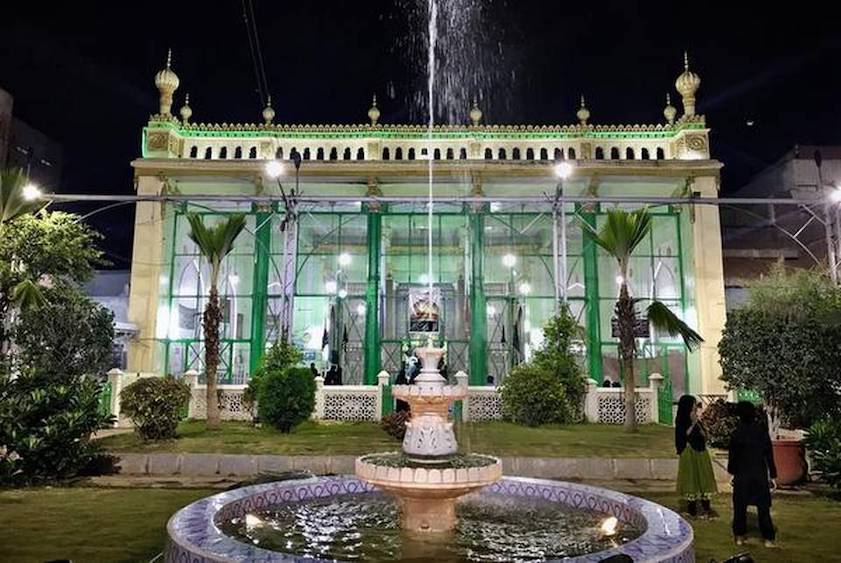Hyderabad: Badshahi Ashoorkhana
This is a collection of articles archived for the excellence of their content. |
History
Serish Nanisetti, A time to remember, October 2, 2018: The Hindu

From: Serish Nanisetti, A time to remember, October 2, 2018: The Hindu
Muhammad Quli Qutb Shah, the founder of Hyderabad, identified himself as a Shia and turned Muharram into a state symbol of piety and mourning. Though Charminar and the Charkaman archways are well known as having been built to by Muhammad Quli, a much more stunning example of the king’s contribution to the city is the Ashoorkhana called Badshahi Ashoorkhana near Madina area of the city.
The Ashoorkhana turns into a pilgrimage site when alams (battle standards) are installed to commemorate the battle of Karbala in 680 A.D. Ashoora or 10th day of Muharram is when the battle took place. The monument was lost for several decades when Emperor Aurangzeb’s forces turned it into a bandikhana to keep wheeled vehicles. Much later, the September 1908 floods caused havoc, washing away some tiles. In a shocking turn of events, it was turned into a garage and parking space at one time. A legal battle waged by the Moosavi family made the monument accessible again, and conservation moves followed the eviction of squatters.
Restoration
Restoration by Telangana government and Aga Khan Trust
Serish Nanisetti, A race to save Hyderabad’s Ashoorkhana, June 4, 2018: The Hindu

The Hindu
K.V.S. GIRI
From: Serish Nanisetti, A race to save Hyderabad’s Ashoorkhana, June 4, 2018: The Hindu
Telangana government and Aga Khan Trust are working to restore the monument ahead of rains
It is a race against the monsoon as Hyderabad’s 17th century Badshahi Ashoorkhana, famed for its resplendent tile work, is restored to its original finery. The sprawling structure, which turns into a house of mourning during Muharram, is located on a narrow bylane of the old city. On Sunday, workers were busy plastering a high wall with brownish lime mortar in the blistering sun, using the cover of a blue tarpaulin.
On another side of the wall where the restoration is taking place, framed by an arched entrance, is the 400-year old Ashoorkhana. It was built sometime in 1611 by Hyderabad’s founder Muhammad Quli Qutb Shah.
“We are consolidating the structure before the monsoon sets in. The documentation is also being done in parallel. Once that is over, we will decide on a conservation plan. The tile work has very fine detailing. At some points, the tiles have been painted over. This will require painstaking documentation,” says N. R. Visalatchy of the Telangana Department of Archaeology and Museums.
The documentation is being done by the Aga Khan Trust for Culture (AKTC), with which the State government has signed a Memorandum of Understanding. “We have to do the work before the monsoon because there are points from which seepage might occur and that will affect the tiles,” says Prashant Banerjee of the AKTC. The restoration is a challenge because materials must be moved through a narrow lane.
Heritage recovered
The restorers are using a lime mortar mix for plastering, but that is not their only weapon. “Pulped and cured wood apple is injected into the gaps. It works like a silicone sealant that expands and contracts without letting the water in. Concrete sealants become rigid, and seepage happens,” says Mr. Banerjee.
The Ashoorkhana turns into a pilgrimage site when alams (battle standards) are installed to commemorate the battle of Karbala in 680 A.D. Ashoora or 10th day of Muharram is when the battle took place. The monument was lost for several decades when Emperor Aurangzeb’s forces turned it into a bandikhana to keep wheeled vehicles. Much later, the September 1908 floods caused havoc, washing away some tiles. In a shocking turn of events, it was turned into a garage and parking space at one time. A legal battle waged by the Moosavi family made the monument accessible again, and conservation moves followed the eviction of squatters.